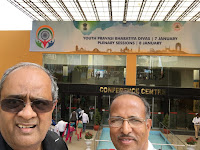 |
| Ramesh (L) & Rao (R) at PBD 2017 |
 n January 9, 1915,
a 45-year old M. K. Gandhi set foot in India after an extraordinary run-in with the South African government. Through a no less extraordinary journey in the next decades, he would be instrumental in the freeing of India from British rule. Mahatma Gandhi is highly, and deservedly, regarded as the greatest Pravasi — प्रवासी — and, since 2004, the Government of India has been sponsoring a yearly convention of प्रवासी भारतीयs, or non-resident Indians (NRIs).
n January 9, 1915,
a 45-year old M. K. Gandhi set foot in India after an extraordinary run-in with the South African government. Through a no less extraordinary journey in the next decades, he would be instrumental in the freeing of India from British rule. Mahatma Gandhi is highly, and deservedly, regarded as the greatest Pravasi — प्रवासी — and, since 2004, the Government of India has been sponsoring a yearly convention of प्रवासी भारतीयs, or non-resident Indians (NRIs).This year, in 2017, my BE classmate & I had occasion to attend the convention together.
This year's Pravasi Bharatiya Divas was held in Bengaluru. Nearly 1,800 NRIs, along with about 5,400 resident Indian (RI) delegates, attended the convention. (Pravasi Bharatiya Divas kicks off in Bengaluru).
(From Outcome Budget 2016-17, Government of India, Ministry of External Affairs, we find that the allocation of funds by the Government of India for the Pravasi Bharatiya Divas 2017 is ₹5 Crores, or about $750,000 in today's dollars. I imagine the hosting state, Karnataka this year, will pick up the tab on whatever else is required).
To my mind, the highlight of the convention was definitely the heartwarming welcome by Prime Minister Modi. It reassured me that politicians can be more effective if they can touch the hearts of the people rather than use mere clichés. To quote from his speech:
- "... एक ऐसा पर्व है, जिस में host भी आप ही हैं, guest भी आप ही हैं।" (Translation: This is such a time in which you -- NRIs -- are both hosts and guests).
- "... आपका इस पर्व में सम्मिलित होना, हमारे लिए बहुत, बहुत, गर्व की बात है।" (Translation: Your gathering at this event is a matter of great pride for us).

The Indian Government has created a rich repertoire of Government Initiatives, Flagship Programs, Policies, Infrastructure Initiatives and Services activities to aid the प्रवासी भारतीयs, or non-resident Indians (NRIs), in their contribution to their native motherland. A couple of interesting programs are Know India Program (KIP) aimed at the NRI youth, Startup India to foster entrepreneurship throughout India, and Digital India to digitization many aspects of the Indian economy. An entire day, Jan 7, was devoted to the NRI youth although, as a non-youth, I found it quite interesting too!
The Exhibition Halls were well represented by all the states touting their own hospitable conditions for industrial cooperation with NRIs.
The Karnataka Government, the host state, has created many initiatives of its own. The NRI Policy of Karnataka, by the Commerce & Industries Department, is a good resource. The Government also has a well laid-out Startup Policy.
The President of India presented 30 awardees with the प्रवासी भारतीय सन्मान पुरस्कार medals.
Since both of us stayed in South Bangalore, we found it exciting to commute to the convention venue by a combination of Uber, Metro & Shuttle. Uber and Metro rides were quite pleasant. (Rao is a Switzerland resident and hence is very knowledgeable about train rides). However, the shuttle ride, particularly from the venue back to the Nagasandra Metro station, was not well-organized. Even though there were plaques throughout the venue announcing the shuttle service every 10-15 minutes, the shuttle buses were nowhere to be found, particularly if you wanted to return during non-regular hours, and no one among the organizer community seemed to know how to help us. (Once I had to take a rural bus, and not the shuttle, to reach Nagasandra).
Overall, though, it was a highly satisfactory experience attending the convention: There are definite possibilities for an NRI to choose a particular method of contribution to suit his/her style and background.
 |
| Pravasi Bharatiya Medal |
 |
| Public transit between South Bangalore and BIEC, the convention venue. |
Overall, though, it was a highly satisfactory experience attending the convention: There are definite possibilities for an NRI to choose a particular method of contribution to suit his/her style and background.
No comments:
Post a Comment